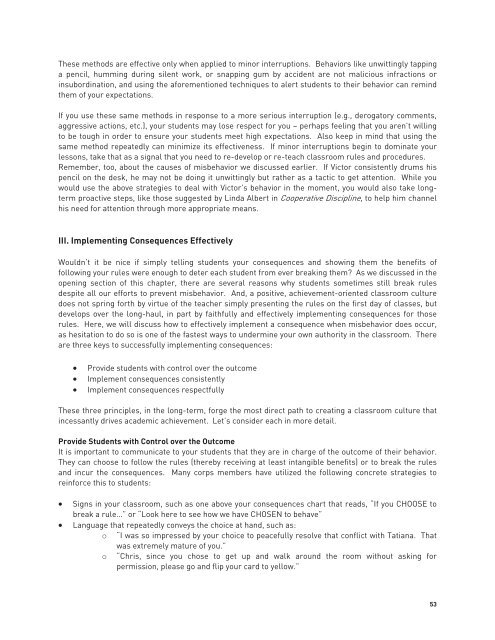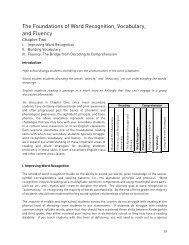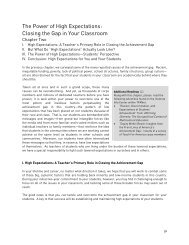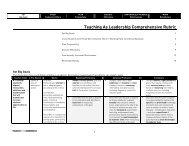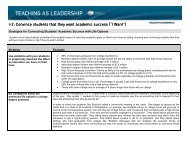Responding to Misbehavior - Teaching As Leadership
Responding to Misbehavior - Teaching As Leadership
Responding to Misbehavior - Teaching As Leadership
Create successful ePaper yourself
Turn your PDF publications into a flip-book with our unique Google optimized e-Paper software.
These methods are effective only when applied <strong>to</strong> minor interruptions. Behaviors like unwittingly tapping<br />
a pencil, humming during silent work, or snapping gum by accident are not malicious infractions or<br />
insubordination, and using the aforementioned techniques <strong>to</strong> alert students <strong>to</strong> their behavior can remind<br />
them of your expectations.<br />
If you use these same methods in response <strong>to</strong> a more serious interruption (e.g., deroga<strong>to</strong>ry comments,<br />
aggressive actions, etc.), your students may lose respect for you – perhaps feeling that you aren’t willing<br />
<strong>to</strong> be <strong>to</strong>ugh in order <strong>to</strong> ensure your students meet high expectations. Also keep in mind that using the<br />
same method repeatedly can minimize its effectiveness. If minor interruptions begin <strong>to</strong> dominate your<br />
lessons, take that as a signal that you need <strong>to</strong> re-develop or re-teach classroom rules and procedures.<br />
Remember, <strong>to</strong>o, about the causes of misbehavior we discussed earlier. If Vic<strong>to</strong>r consistently drums his<br />
pencil on the desk, he may not be doing it unwittingly but rather as a tactic <strong>to</strong> get attention. While you<br />
would use the above strategies <strong>to</strong> deal with Vic<strong>to</strong>r’s behavior in the moment, you would also take longterm<br />
proactive steps, like those suggested by Linda Albert in Cooperative Discipline, <strong>to</strong> help him channel<br />
his need for attention through more appropriate means.<br />
III. Implementing Consequences Effectively<br />
Wouldn’t it be nice if simply telling students your consequences and showing them the benefits of<br />
following your rules were enough <strong>to</strong> deter each student from ever breaking them? <strong>As</strong> we discussed in the<br />
opening section of this chapter, there are several reasons why students sometimes still break rules<br />
despite all our efforts <strong>to</strong> prevent misbehavior. And, a positive, achievement-oriented classroom culture<br />
does not spring forth by virtue of the teacher simply presenting the rules on the first day of classes, but<br />
develops over the long-haul, in part by faithfully and effectively implementing consequences for those<br />
rules. Here, we will discuss how <strong>to</strong> effectively implement a consequence when misbehavior does occur,<br />
as hesitation <strong>to</strong> do so is one of the fastest ways <strong>to</strong> undermine your own authority in the classroom. There<br />
are three keys <strong>to</strong> successfully implementing consequences:<br />
Provide students with control over the outcome<br />
Implement consequences consistently<br />
Implement consequences respectfully<br />
These three principles, in the long-term, forge the most direct path <strong>to</strong> creating a classroom culture that<br />
incessantly drives academic achievement. Let’s consider each in more detail.<br />
Provide Students with Control over the Outcome<br />
It is important <strong>to</strong> communicate <strong>to</strong> your students that they are in charge of the outcome of their behavior.<br />
They can choose <strong>to</strong> follow the rules (thereby receiving at least intangible benefits) or <strong>to</strong> break the rules<br />
and incur the consequences. Many corps members have utilized the following concrete strategies <strong>to</strong><br />
reinforce this <strong>to</strong> students:<br />
Signs in your classroom, such as one above your consequences chart that reads, “If you CHOOSE <strong>to</strong><br />
break a rule…” or “Look here <strong>to</strong> see how we have CHOSEN <strong>to</strong> behave”<br />
Language that repeatedly conveys the choice at hand, such as:<br />
o “I was so impressed by your choice <strong>to</strong> peacefully resolve that conflict with Tatiana. That<br />
was extremely mature of you.”<br />
o “Chris, since you chose <strong>to</strong> get up and walk around the room without asking for<br />
permission, please go and flip your card <strong>to</strong> yellow.”<br />
53


